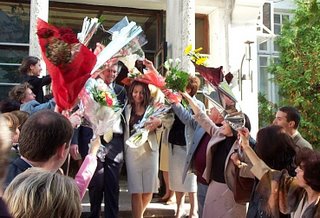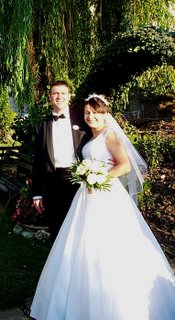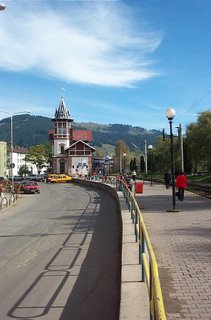Monday, October 30, 2006
A Tale of Two Conferences
Tale of Two Conferences
In an earlier post I described the organization that Nancy volunteers with, the Societatea Ornitologica Romana. This entry I’ll talk a little about my organization. Bioterra, the Association of Organic Farmers’ of Romania, is a non-governmental (non-profit) group that encourages organic farming in Romania. It has close ties with the Agricultural University here in Cluj and both educates and promotes the cause of ecologically sound agriculture.
I do what ever I can to assist the organization. It is a small staff of Executive Director, a chief of publications and a person for finance and project development. The two person staff is assisted in auditing and technical problems by members of the Executive Director’s family. The office is located in the back of his home in the village of Luna de Sus and has most of the latest equipment, including, just recently, high speed internet.
On the 21st and 22nd of October Bioterra hosted the 7th international conference of its members, potential members, government and agriculture officials and friends here in Cluj. Seven hundred invitations went out and nearly 300 people attended. Holding a conference of this size in four different languages is a bit of a challenge for our crew, but all the necessary copying, packet stuffing, sorting, name tagging was completed with too much of a hitch.
During the conference, the task I assigned myself, was to sell the publications of the organization. Part of the education process is printing information and to date, the association has published 12 books on various aspects of organic farming. We also do a quarterly magazine in both Romanian and Hungarian. At the conference, I stood in the auditorium lobby with the books spread in front of me and I smiled and explained the cost of each book. Nancy also had her bird pins available for sale, and between the books and the pins we were kept busy.
The weekend following our conference the organization had received an invitation to attend a similar conference in Serbia. Everyone was exhausted from getting our conference completed and there was not much enthusiasm to go to Serbia so the call went up….. “We’ll send our volunteer. Tim, you’d like to go, wouldn’t you?” Nancy and I spent most of the last three days going and returning from Subotica, Serbia.
You may never have heard of Subotica, Serbia. I hadn’t. It is a town of around 100,000 people that sits just inside the boarder between Serbia and Hungary. The land around the city is flat, as it is part of the great Hungarian plain that stretches across eastern Hungary. There is nothing about the entrance to the city or the Communist era hotel that would make you think that there is any merit to the place, but once in the main center, it was astonishing to see the extravagant town hall and the buildings and commerce of the town.
The first afternoon of the conference I gave a short presentation as to the state of organic agriculture in Romania and met with many of the local and international representatives attending. The Subotica conference had fewer attendees than the Romanian one but this was only their second annual whereas ours was our seventh. What is interesting is to see how each country is trying to promote the ecological and health advantages of organic production. There is a network of connectivity and I hope that I strengthened the link between Romania and Serbia in some small way.
I’ll try and attach a couple of pictures showing, first my book table at the Cluj conference and then a scene from Subotica.
Monday, October 23, 2006
Friday, October 20, 2006
Nunta
Nunta
Last weekend Nancy and I crammed into a ‘maxi-taxi’ and rode the six hours through the heart of Transylvania to the city of Pitesti to attend out first Romanian Nunta - wedding. Weddings are a big deal here, very big. Usually they last for three days and feature at least two ceremonies. The civil ceremony is held in the house of weddings at the branch of the local city hall. A functionary representing the mayor’s office presides as the bride and groom sign the official book stating that they are man and wife.
City hall is kind enough to provide a glass of champagne and a biscuit to the wedding party, who then proceed beneath an arbor of flowers held aloft by the guests. On the Saturday morning of the wedding we attended there was a line of bride and grooms waiting to become official. Our group was scheduled for 10:30, but there was a back up of at least 4 weddings still in front of us at that hour, a few behind so we stood out along the street waiting our turn. Our bride was careful to avoid spying other brides because it is considered a bad omen to see a new bride on your wedding day prior to your own wedding.
Later that afternoon we attended the church ceremony. This took place in an orthodox church, the service in Romanian. Here too we had to wait for the ceremony before ours to finish and there was at least one other following. Once inside it was a treat to study the similarities and the differences between services that we are used to and the orthodox as practiced in Romania. There are no seats in the church so the well wishers all stood watching the priests – three of them – administer to the couple. This was a mixed wedding, an American, Brian and a Romanian, Anca. Brian is a former volunteer in the group that came just before ours did and Anca was his and our language teacher.
There was a good bit of canting and incense and prayers and much made of the ring and the crowns that both Brian and Anca wore. Toward the conclusion the main participants danced around the alter led by the high priest. After the sermon – here the priest was surprised to learn that Brian knew Romanian – in which it was suggested that the couple have seven children, we all gathered in the garden outside for pictures. The bride and groom got to keep the rings but the crowns went back to be used for the next wedding. And there were lots of pictures. Romanians love taking pictures. Best man and bride's maid do not hold much sway in Romanian ceremonies,- they get to hold the long candles during the service but not much else. Their place of importance is taken by ‘God parents’ who shepard the couple through the events of the weekend. Brian and Anca had Romanian God parents from the city of Sibiu.
That evening we partied. Our party was one of three held in the hotel that night. Dinner started at 8 pm, but the band didn’t arrive until 12 along with the third of six of courses of the dinner. Romanians love to party and dance and once the band showed, we were soon all joining hands and dancing around the dance floor. We made it through the dinner’s fourth course at 2 am and then retired to bed 3 hours before the scheduled ending.
The wedding guests included about fifteen family and friends of the groom, many graduates of the University of Virginia and JMU. When we left the party the Romanians were well under control, the UVA boys were having a harder time of it, not being accustomed to the strong local brews.
Our best wishes go to Brian and Anca, and our thanks for including us on the guest list. They come from two different cultures but they are liked minded people and we believe that they will make a good success of their lives together.
Wednesday, October 11, 2006
Tuesday, October 10, 2006
Brindusa de Toamna
Brindusa de Toamna
Romania’s beauty is in its countryside and a good deal of that beauty is covered in wildflowers. Many of the trees and shrubs are surprisingly familiar to me, having migrated from the old world to the new, or vice versa. Especially in springtime it is comforting to see old familiar species. A Romanian garden, either flower or vegetable would be very similar to an American with the exception of a difference in the preference of a variety of peppers, both here and there. Domesticated flowers and most vegetable and even many field crops are similar but many of the wildflowers that sprout in the meadows and hillsides are unfamiliar to me. It has been a joy to watch the various blooms and colors of the fields and pastures. Whenever I manage to find a way to travel in the countryside I take real pleasure as one season's flowers turn into another.
One that we do have in the United States is the fall crocus, but it is not nearly as common there as here. In Romania, it has naturalized completely. Certain fields, particularly those along the stream floodplains, are covered in the pale purple cups the last week of September and the first week of October. Romanian for crocus is Brandusa. Thus Brindusa de Toamna are the fall crocus and along with common asters are about the last of the cycle of color.
All women’s names in Romania end with the letter A, with the one exception of Carmen. There are very many pretty names, all softened by the addition of that A. We are much indebted to a young couple Marius and Brindusa, and whenever I see a field blooming with the fall crocus I think of the kindnesses that he and she have offered.
Last weekend a small group of us paid a visit to the mountain resort of Vatra Dornei. It is a small city with a small ski slope. The mountains are covered in pine and spruce forests and the colors of the fall were spread along the hillsides. Unlike everywhere else in the country, farm houses and fenced areas dot the cultivated plots. In the woods in this area grow mushrooms. I haven’t tried any that I’ve picked myself, but there is a local industry that gathers and sells the autumn mushrooms. I’ve included a picture of mushrooms taken in the old Jewish cemetery at Vatra Dornei.








